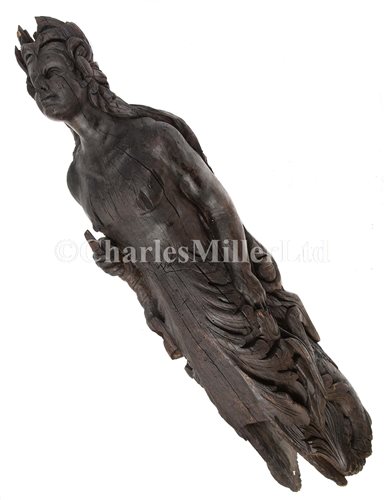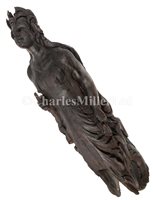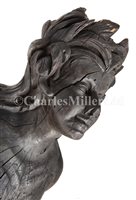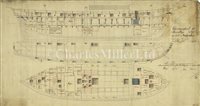10th May, 2016 12:00
Maritime and Scientific Models, Instruments & Art ('Courageous')
182
[M] AN HISTORICALLY INTERESTING FIGUREHEAD FROM...
carved from a solid piece of stained pine in the form of a three-quarter length depiction of Ceres holding a cornucopia in her right hand and wearing a diadem over flowing locks of hair, terminating in a foliate and scrolled slotted foot -- 72in. (183cm.) high
Launched at Nyholm dockyard in May 1820 and classified as a Fifth Rate of 20-guns, this was the third vessel to carry this name - her immediate predecessor (a 36-gun frigate) of 1811 having been sunk in 1812 at the Battle of Lyngør by the British Royal Navy. Quickly fitted out, she embarked that September for the first of three expeditions to the West Indies before finally returning in 1826. Used thereafter as a cadet training ship, she became a guard ship in 1844 which, apart from a short stint in active service during a national emergency in 1848, was a rôle she remained in until 1851 when decommissioned and sold. It seems probable that the Navy removed her decorative scheme before selling the ship to the merchants H. Puggaard & Co. and she made several more trips to the West Indies. It is believed she caught fire when transporting gold diggers to Alaska and became a total loss sometime in the 1850s
The choice of Ceres is appropriate for a vessel used for voyages to the West Indies. The goddess of agriculture, she is associated with plenty and is usually depicted wearing a crown of corn and carrying a sheath of corn or cornucopia as here. In mythology, her daughter, Proserpine was abducted by Pluto causing Ceres to travel everywhere in search of her, during which time crops wouldn't grow.
Condition Report
Stripped but stained, old shrinkage cracks and some old chips/losses commensurate with age.
We are pleased to provide you with a general report of the condition of this property. Since we are not professional conservators or restorers, we urge you to consult with a restorer or conservator of your choice who will be better able to provide a detailed, professional report. Prospective buyers should inspect each lot to satisfy themselves as to condition and must understand that any statement made by Charles Miller Ltd is merely a subjective, qualified opinion. Prospective buyers should also refer to any Important Notices regarding this sale, which are printed in the Sale Catalogue. NOTWITHSTANDING THIS REPORT OR ANY DISCUSSIONS CONCERNING A LOT, ALL LOTS ARE OFFERED AND SOLD “AS IS” IN ACCORDANCE WITH THE CONDITIONS OF BUSINESS PRINTED IN THE SALE CATALOGUE.
carved from a solid piece of stained pine in the form of a three-quarter length depiction of Ceres holding a cornucopia in her right hand and wearing a diadem over flowing locks of hair, terminating in a foliate and scrolled slotted foot -- 72in. (183cm.) high
Launched at Nyholm dockyard in May 1820 and classified as a Fifth Rate of 20-guns, this was the third vessel to carry this name - her immediate predecessor (a 36-gun frigate) of 1811 having been sunk in 1812 at the Battle of Lyngør by the British Royal Navy. Quickly fitted out, she embarked that September for the first of three expeditions to the West Indies before finally returning in 1826. Used thereafter as a cadet training ship, she became a guard ship in 1844 which, apart from a short stint in active service during a national emergency in 1848, was a rôle she remained in until 1851 when decommissioned and sold. It seems probable that the Navy removed her decorative scheme before selling the ship to the merchants H. Puggaard & Co. and she made several more trips to the West Indies. It is believed she caught fire when transporting gold diggers to Alaska and became a total loss sometime in the 1850s
The choice of Ceres is appropriate for a vessel used for voyages to the West Indies. The goddess of agriculture, she is associated with plenty and is usually depicted wearing a crown of corn and carrying a sheath of corn or cornucopia as here. In mythology, her daughter, Proserpine was abducted by Pluto causing Ceres to travel everywhere in search of her, during which time crops wouldn't grow.
Auction: Maritime and Scientific Models, Instruments & Art ('Courageous'), 10th May, 2016




